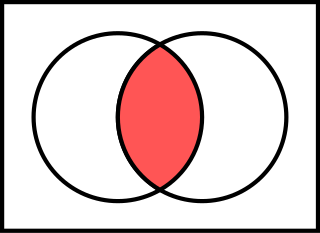
In logic, mathematics and linguistics, And (∧) is the truth-functional operator of logical conjunction; the and of a set of operands is true if and only if all of its operands are true. The logical connective that represents this operator is typically written as ∧ or ⋅ .
In electronics, a logic gate is an idealized or physical device implementing a Boolean function; that is, it performs a logical operation on one or more binary inputs and produces a single binary output. Depending on the context, the term may refer to an ideal logic gate, one that has for instance zero rise time and unlimited fan-out, or it may refer to a non-ideal physical device.

In electronics, a multiplexer is a device that combines several analog or digital input signals and forwards them into a single output line. A multiplexer of inputs has select lines, which are used to select which input line to send to the output. Multiplexers are mainly used to increase the amount of data that can be sent over the network within a certain amount of time and bandwidth. A multiplexer is also called a data selector. Multiplexers can also be used to implement Boolean functions of multiple variables.
In cryptography, an S-box (substitution-box) is a basic component of symmetric key algorithms which performs substitution. In block ciphers, they are typically used to obscure the relationship between the key and the ciphertext — Shannon's property of confusion.

In logic circuits, the Toffoli gate, invented by Tommaso Toffoli, is a universal reversible logic gate, which means that any reversible circuit can be constructed from Toffoli gates. It is also known as the "controlled-controlled-not" gate, which describes its action. It has 3-bit inputs and outputs; if the first two bits are both set to 1, it inverts the third bit, otherwise all bits stay the same.

In cryptography, the avalanche effect is the desirable property of cryptographic algorithms, typically block ciphers and cryptographic hash functions, wherein if an input is changed slightly, the output changes significantly. In the case of high-quality block ciphers, such a small change in either the key or the plaintext should cause a drastic change in the ciphertext. The actual term was first used by Horst Feistel, although the concept dates back to at least Shannon's diffusion.
In Boolean algebra, any Boolean function can be put into the canonical disjunctive normal form (CDNF) or minterm canonical form and its dual canonical conjunctive normal form (CCNF) or maxterm canonical form. Other canonical forms include the complete sum of prime implicants or Blake canonical form, and the algebraic normal form.
Grain is a stream cipher submitted to eSTREAM in 2004 by Martin Hell, Thomas Johansson and Willi Meier. It has been selected for the final eSTREAM portfolio for Profile 2 by the eSTREAM project. Grain is designed primarily for restricted hardware environments. It accepts an 80-bit key and a 64-bit IV. The specifications do not recommended a maximum length of output per pair. A number of potential weaknesses in the cipher have been identified and corrected in Grain 128a which is now the recommended cipher to use for hardware environments providing both 128bit security and authentication.

XOR gate is a digital logic gate that gives a true output when the number of true inputs is odd. An XOR gate implements an exclusive or; that is, a true output results if one, and only one, of the inputs to the gate is true. If both inputs are false (0/LOW) or both are true, a false output results. XOR represents the inequality function, i.e., the output is true if the inputs are not alike otherwise the output is false. A way to remember XOR is "one or the other but not both".
Because the NAND function has functional completeness all logic systems can be converted into NAND gates – the mathematical proof for this was published by Henry M. Sheffer in 1913 in the Transactions of the American Mathematical Society. This is also true for NOR gates. In principle, any combinatorial logic function can be realized with enough NAND gates.
In mathematics, the correlation immunity of a Boolean function is a measure of the degree to which its outputs are uncorrelated with some subset of its inputs. Specifically, a Boolean function is said to be correlation-immune of order m if every subset of m or fewer variables in is statistically independent of the value of .
In computational complexity theory and circuit complexity, a Boolean circuit is a mathematical model for digital logic circuits. A formal language can be decided by a family of Boolean circuits, one circuit for each possible input length. Boolean circuits are also used as a formal model for combinational logic in digital electronics.
In theoretical computer science, circuit complexity is a branch of computational complexity theory in which Boolean functions are classified according to the size or depth of Boolean circuits that compute them. One speaks of the circuit complexity of a Boolean circuit. A related notion is the circuit complexity of a recursive language that is decided by a uniform family of circuits .
In cryptography, a T-function is a bijective mapping that updates every bit of the state in a way that can be described as , or in simple words an update function in which each bit of the state is updated by a linear combination of the same bit and a function of a subset of its less significant bits. If every single less significant bit is included in the update of every bit in the state, such a T-function is called triangular. Thanks to their bijectivity regardless of the used Boolean functions and regardless of the selection of inputs, T-functions are now widely used in cryptography to construct block ciphers, stream ciphers, PRNGs and hash functions. T-functions were first proposed in 2002 by A. Klimov and A. Shamir in their paper "A New Class of Invertible Mappings". Ciphers such as TSC-1, TSC-3, TSC-4, ABC, Mir-1 and VEST are built with different types of T-functions.

In cryptography, a permutation box is a method of bit-shuffling used to permute or transpose bits across S-boxes inputs, retaining diffusion while transposing.
A truth table is a mathematical table used in logic—specifically in connection with Boolean algebra, boolean functions, and propositional calculus—which sets out the functional values of logical expressions on each of their functional arguments, that is, for each combination of values taken by their logical variables. In particular, truth tables can be used to show whether a propositional expression is true for all legitimate input values, that is, logically valid.
Garbled circuit is a cryptographic protocol that enables two-party secure computation in which two mistrusting parties can jointly evaluate a function over their private inputs without the presence of a trusted third party. In the garbled circuit protocol, the function has to be described as a Boolean circuit.
In mathematics and mathematical logic, Boolean algebra is the branch of algebra in which the values of the variables are the truth values true and false, usually denoted 1 and 0 respectively. Instead of elementary algebra where the values of the variables are numbers, and the prime operations are addition and multiplication, the main operations of Boolean algebra are the conjunction and denoted as ∧, the disjunction or denoted as ∨, and the negation not denoted as ¬. It is thus a formalism for describing logical relations in the same way that elementary algebra describes numeric relations.









